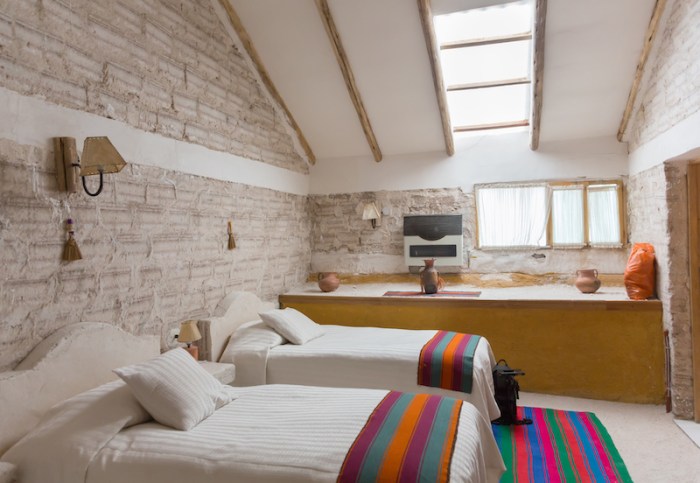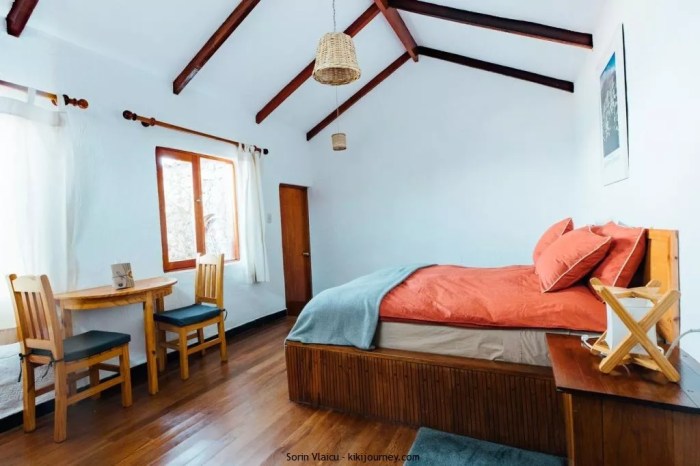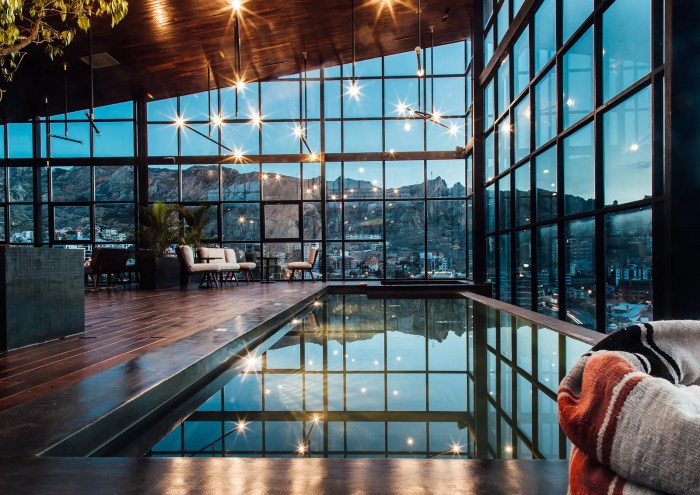Best eco-friendly hotels in Bolivia with stunning natural surroundings
Best eco-friendly hotels in Bolivia with stunning natural surroundings offer a unique travel experience. Imagine waking up to breathtaking Andean views, the Amazon rainforest’s vibrant sounds, or the serene beauty of the Altiplano, all while knowing your stay supports sustainable practices. This guide explores Bolivia’s best eco-lodges, highlighting their commitment to environmental responsibility and the unforgettable experiences they offer.
From the lush Amazon basin to the towering Andes and the high-altitude plains of the Altiplano, Bolivia boasts incredible biodiversity and dramatic landscapes. We’ll delve into what defines an eco-friendly hotel in this diverse context, examining various certifications and the specific sustainable practices employed. We’ll showcase hotels that seamlessly blend luxury with conservation, offering unique activities that respect both the environment and local communities.
Discover how these hotels provide exceptional guest experiences while contributing to the preservation of Bolivia’s natural wonders.
Defining “Eco-Friendly” in the Bolivian Context

Source: uyuniguide.com
Defining “eco-friendly” for Bolivian hotels requires considering the unique environmental challenges and cultural nuances of the country. Bolivia possesses incredibly diverse ecosystems, from the Amazon rainforest to the Altiplano, each facing specific threats like deforestation, water scarcity, and pollution. Simultaneously, respect for indigenous cultures and their traditional sustainable practices is paramount. Therefore, eco-friendliness in this context goes beyond simply reducing carbon emissions; it encompasses a holistic approach to sustainability that integrates environmental protection with socio-cultural responsibility.Eco-friendly hotels in Bolivia should prioritize minimizing their environmental footprint while supporting local communities and preserving the country’s rich biodiversity.
This involves a commitment to responsible resource management, waste reduction, and community engagement. It also means embracing sustainable tourism practices that benefit both the environment and local people.
Eco-Certification Standards in Bolivia
Several eco-certification standards are applicable to Bolivian hotels, each with its own set of criteria. While some are internationally recognized, others are specific to Bolivia or the region. These certifications provide a framework for hotels to demonstrate their commitment to sustainability and attract environmentally conscious travelers. However, the level of stringency and specific requirements can vary significantly.
Bolivia offers incredible eco-friendly hotels nestled in breathtaking natural landscapes, a stark contrast to the urban charm found elsewhere. For a different kind of architectural experience, consider exploring the rich history and vibrant street art of George Town, Penang, by checking out hotels showcased here: Hotels in George Town, Penang with colonial architecture and street art. Then, return to Bolivia’s stunning scenery and sustainable accommodations for a truly diverse travel experience.
A lack of widespread adoption of a single standard can lead to inconsistencies in the application of eco-friendly practices. For example, a hotel certified under one standard might have higher standards for water conservation than another hotel certified under a different standard.
Sustainable Practices Prioritized in Bolivian Hotels
Water conservation is crucial, especially in arid regions like the Altiplano. Hotels should implement water-saving technologies like low-flow showerheads and toilets, rainwater harvesting systems, and efficient irrigation for landscaping. Waste management is equally important, with a focus on reducing, reusing, and recycling waste. This includes composting organic waste, implementing effective recycling programs, and minimizing single-use plastics. Energy efficiency is another key area, involving the use of renewable energy sources like solar power, energy-efficient lighting and appliances, and responsible energy consumption practices.
Furthermore, hotels should source food locally to reduce transportation emissions and support local farmers, and prioritize sustainable building materials and construction techniques. Finally, engaging with and supporting local communities through employment opportunities, fair wages, and community development projects is vital for ensuring the long-term sustainability of tourism in Bolivia.
Comparison of Eco-Friendly Hotel Certifications
| Certification | Focus | Key Requirements | Geographic Applicability |
|---|---|---|---|
| Global Sustainable Tourism Council (GSTC) | Global standard for sustainable tourism | Environmental management, socio-economic aspects, cultural preservation | International |
| Green Globe | Comprehensive environmental and social sustainability | Waste management, energy efficiency, water conservation, community engagement | International |
| LEED (Leadership in Energy and Environmental Design) | Building design and construction | Sustainable site development, water efficiency, energy efficiency, material selection | International |
| (Hypothetical Bolivian Certification – Example) “Eco-Andes” | Focus on Andean region sustainability | Water conservation adapted to high-altitude conditions, preservation of Andean biodiversity, support for local indigenous communities | Bolivia (Andean region) |
Identifying Stunning Natural Surroundings in Bolivia: Best Eco-friendly Hotels In Bolivia With Stunning Natural Surroundings
Bolivia boasts an incredible diversity of landscapes, offering a breathtaking array of natural environments for eco-conscious travelers. From the lush Amazon rainforest to the towering Andes mountains and the high-altitude Altiplano, the country provides a unique backdrop for sustainable tourism. Choosing an eco-friendly hotel in Bolivia means not only supporting responsible practices but also immersing yourself in some of the most spectacular scenery on Earth.Bolivia’s diverse ecosystems provide unique opportunities for eco-tourism.
Understanding these environments and the hotels situated within them allows travelers to make informed choices that align with their interests and contribute to the preservation of these fragile ecosystems.
Amazon Rainforest Hotels and Experiences
The Bolivian Amazon, a part of the vast Amazon basin, is characterized by its dense rainforest, abundant biodiversity, and intricate river systems. Hotels in this region often focus on providing immersive experiences that connect guests with the natural world. Imagine waking to the sounds of howler monkeys, embarking on guided jungle treks to spot vibrant macaws, or paddling down tranquil rivers in search of pink river dolphins.
Examples include lodges that offer sustainable accommodation integrated into the forest canopy, allowing for minimal environmental impact. These accommodations typically emphasize local employment and community engagement, reinforcing the commitment to sustainable practices. The experience is enhanced by the sheer scale and vibrancy of the rainforest, with the sounds and smells of the jungle creating an unforgettable atmosphere.
- Advantages: Unique wildlife viewing opportunities, immersive jungle experiences, opportunities for sustainable community tourism.
- Disadvantages: Accessibility can be challenging, weather can be unpredictable and humid, potential for insect bites and other discomforts.
Andes Mountain Hotels and Experiences, Best eco-friendly hotels in Bolivia with stunning natural surroundings
The Andes Mountains dominate much of Bolivia’s western landscape, offering dramatic scenery, high-altitude lakes, and unique flora and fauna adapted to challenging conditions. Hotels nestled in the Andes often provide breathtaking views of snow-capped peaks, picturesque valleys, and vibrant Andean communities. Imagine staying in a charming lodge built with local materials, enjoying traditional Andean cuisine, and hiking through stunning mountain passes.
Some hotels offer opportunities for trekking, mountain biking, and exploring nearby villages, immersing guests in the rich cultural heritage of the region. The majestic views and the sense of adventure contribute to a truly memorable experience.
- Advantages: Stunning mountain scenery, opportunities for hiking and trekking, exposure to Andean culture and traditions.
- Disadvantages: High altitude can cause altitude sickness, weather can be unpredictable and harsh, accessibility can be limited in certain areas.
Altiplano Hotels and Experiences
The Altiplano, a high-altitude plateau, is characterized by its vast expanse, unique ecosystems, and stunning landscapes. Hotels in this region often offer a glimpse into the unique culture and environment of the Andes, providing opportunities to witness the breathtaking beauty of Salar de Uyuni, the world’s largest salt flat. Imagine waking up to a sunrise painting the salt flats in vibrant colors, exploring the surreal landscape, and learning about the indigenous communities that call this region home.
Many hotels emphasize sustainable practices, using solar energy and employing local staff. The surreal beauty of the Altiplano and the unique cultural experiences it offers create a truly unforgettable travel experience.
- Advantages: Unique and surreal landscapes, opportunities for wildlife viewing (flamingos, vicuñas), cultural immersion in indigenous communities.
- Disadvantages: Extreme altitude can cause altitude sickness, weather can be unpredictable and harsh, limited vegetation and biodiversity compared to other regions.
Hotel Features and Amenities

Source: kikijourney.com
Bolivia offers incredible eco-friendly hotels nestled in breathtaking landscapes, a stark contrast to the urban buzz of Kuala Lumpur. If you’re looking for a different kind of adventure, check out hotels near iconic landmarks like the Petronas Twin Towers; you can find great options by visiting Hotels in Kuala Lumpur with easy access to Petronas Twin Towers.
But for those seeking tranquility amidst nature, Bolivia’s eco-lodges are an unparalleled experience.
High-quality eco-friendly hotels in Bolivia go beyond simply minimizing their environmental impact; they offer a luxurious and enriching experience that seamlessly integrates sustainability into every aspect of the guest’s stay. These hotels prioritize comfort and unique cultural immersion while showcasing responsible practices. The features and amenities are carefully selected to minimize their ecological footprint without compromising the quality of service expected by discerning travelers.
Eco-lodges in Bolivia often showcase a unique blend of traditional Bolivian architecture and modern sustainable design. This creates a captivating atmosphere that reflects the country’s rich cultural heritage while promoting environmentally conscious practices. The integration of local materials and skilled craftsmanship is a key element in many of these establishments, supporting local communities and minimizing transportation costs and emissions.
Bolivia offers incredible eco-friendly hotels nestled amidst breathtaking Andean landscapes. For a different kind of stunning scenery, consider luxurious escapes like those found in Krabi, Thailand; check out these Luxury hotels in Krabi with stunning sea views and private beach access for a taste of paradise. But if you prefer a more sustainable travel experience, Bolivia’s eco-lodges provide an equally unforgettable adventure.
Sustainable Amenities Categorization
The amenities offered by eco-friendly hotels in Bolivia can be broadly categorized into energy-saving, water-saving, and waste reduction initiatives. These are not mutually exclusive categories, and many amenities contribute to multiple areas of sustainability.
- Energy Saving: Solar panels for hot water and electricity, energy-efficient lighting (LEDs), smart thermostats, and the use of locally sourced, sustainably harvested wood for construction and furniture.
- Water Saving: Low-flow showerheads and faucets, rainwater harvesting systems for irrigation and toilet flushing, water-efficient landscaping using native drought-tolerant plants.
- Waste Reduction: Composting systems for organic waste, recycling programs for paper, plastic, and glass, the use of reusable items (e.g., towels, water bottles), and minimized use of single-use plastics.
Examples of Eco-Friendly Hotels in Bolivia
Several hotels in Bolivia exemplify the successful integration of sustainable practices and high-quality amenities. While specific examples require further research to confirm current practices, a hypothetical example might include a lodge in the Amazon utilizing solar power, locally sourced building materials, and a comprehensive recycling program, while offering comfortable rooms with stunning jungle views and providing opportunities for educational eco-tours.
Another example could be a hotel in the Altiplano region using traditional Andean building techniques with modern insulation to minimize energy consumption, offering guests locally made textiles and organic meals sourced from nearby communities.
Architectural Styles Across Regions
The architectural styles of eco-lodges vary considerably across Bolivia’s diverse regions. In the Amazon, lodges often feature open-air designs that blend seamlessly with the surrounding rainforest, utilizing natural materials like bamboo and thatch. In contrast, hotels in the Altiplano region may incorporate traditional adobe construction, reflecting the region’s unique climate and building techniques. The Andes mountains might see lodges that use stone and wood, creating a rustic yet comfortable aesthetic.
Bolivia offers incredible eco-friendly hotels nestled amidst breathtaking natural landscapes; think lush rainforests and snow-capped Andes. For a different kind of stunning view, consider city hotels – if you’re looking for something more urban, check out Affordable hotels in Hong Kong with stunning harbor views for a completely different experience. But for those seeking tranquility and nature, Bolivia’s eco-lodges are hard to beat.
These regional variations reflect both the local environment and the cultural heritage of each area, adding to the unique experience offered by each hotel.
Guest Experiences and Activities
Eco-friendly hotels in Bolivia offer guests immersive experiences deeply connected to the country’s rich natural and cultural heritage. These experiences prioritize responsible tourism, minimizing environmental impact and maximizing benefits for local communities. Activities often blend adventure with cultural understanding, creating a truly unforgettable journey.
Guests can expect a range of activities tailored to their interests and fitness levels. Many hotels partner with local guides and communities to offer authentic and sustainable excursions. This ensures that tourism revenue directly benefits the people and places being visited, promoting long-term preservation of Bolivia’s natural beauty and cultural traditions.
Sustainable Excursions and Activities
Many eco-lodges and hotels offer unique excursions designed to minimize environmental impact. These often involve walking or cycling tours, allowing guests to appreciate the landscape at a slower pace. Examples include guided hikes through cloud forests to observe diverse flora and fauna, visits to local communities to learn traditional crafts and ways of life, and birdwatching tours in areas known for their rich avian biodiversity.
Some hotels also arrange stargazing excursions, taking advantage of Bolivia’s clear night skies, away from light pollution. Kayaking or canoeing on pristine lakes, or horseback riding through scenic valleys are other popular options.
Bolivia offers incredible eco-friendly hotels nestled in breathtaking landscapes, perfect for nature lovers. For a completely different adventure, consider a family trip and check out the convenient hotel options near Hong Kong Disneyland, like those listed on this helpful site: Hotels in Kowloon with convenient access to Hong Kong Disneyland. Back to Bolivia, remember to book your eco-lodge well in advance to secure your spot amidst the stunning Bolivian scenery.
Community Engagement and Economic Contribution
Eco-friendly hotels in Bolivia actively contribute to the local economy and community through various initiatives. They often source food and other supplies from local farmers and producers, supporting local businesses and reducing their carbon footprint by minimizing transportation distances. Hotels also employ local staff, providing jobs and skills training within the community. Many hotels participate in community development projects, such as supporting local schools or healthcare initiatives, or funding conservation efforts in the surrounding areas.
Some hotels even offer volunteer opportunities for guests to participate in these projects, enhancing their travel experience while contributing directly to positive change.
Sample 5-Day Eco-Tourism Itinerary
This itinerary showcases a potential 5-day trip highlighting responsible tourism in Bolivia. The specific hotels and activities can be adapted based on individual preferences and budget.
Day 1: Arrive in La Paz, transfer to an eco-lodge near Lake Titicaca. Settle in and enjoy a traditional Bolivian dinner prepared with locally sourced ingredients.
Day 2: Explore Lake Titicaca with a guided boat tour, visiting Uros floating islands and Taquile Island to learn about the unique cultures of the indigenous communities.
Day 3: Travel to the Madidi National Park region and check into an eco-lodge nestled within the rainforest.
Participate in a guided nature walk to observe the incredible biodiversity of the park.
Day 4: Engage in a community-based activity, such as helping with a local reforestation project or learning traditional weaving techniques from local artisans. Enjoy an evening of stargazing.
Day 5: Depart from the Madidi region, reflecting on the enriching experiences and contributions made to the local community and environment.
Transfer to La Paz for your onward journey.
Visual Representation of Eco-Friendly Hotels
The visual appeal of an eco-friendly hotel nestled within Bolivia’s stunning landscapes is crucial. It’s not just about offering sustainable practices; it’s about creating an immersive and aesthetically pleasing experience that reflects the natural beauty of the surroundings. The design should seamlessly blend with the environment, enhancing both the guest experience and the hotel’s eco-credentials.The visual elements of such hotels often emphasize natural materials, local craftsmanship, and a design that minimizes environmental impact.
This approach creates a harmonious relationship between the built environment and the natural world, resulting in a unique and memorable stay for guests. The visual cues communicate the hotel’s commitment to sustainability, attracting environmentally conscious travelers.
Examples of Visually Appealing Eco-Friendly Hotels in Bolivia
Let’s explore three hypothetical examples showcasing how different design approaches can achieve this visual harmony:
Hotel Taypi: The Andean Retreat
Imagine Hotel Taypi, situated high in the Andes. Its architecture is inspired by traditional Bolivian rural designs, using locally sourced stone and timber. The buildings are low-slung, blending seamlessly with the mountainous terrain. Extensive green roofs, planted with native Andean grasses, help regulate temperature and reduce the visual impact of the structures. Large windows frame breathtaking views of snow-capped peaks, connecting the interior with the stunning exterior.
Interior design utilizes natural textiles and locally crafted furniture, creating a warm and inviting atmosphere that respects the local culture.
Hotel Yacuma: Amazonian Oasis
Bolivia offers incredible eco-lodges nestled in breathtaking landscapes, perfect for nature lovers. If you prefer a different kind of adventure, you might consider the stylish urban escape offered by Boutique hotels in Melbourne with unique character and stylish design , but for truly immersive natural beauty, Bolivia’s eco-friendly options are hard to beat. Their commitment to sustainability complements the stunning surroundings.
Hotel Yacuma, nestled within the Amazon rainforest, showcases a different aesthetic. Its design prioritizes openness and integration with the surrounding jungle. Overwater bungalows, constructed from sustainably harvested bamboo and thatch, are raised on stilts to minimize ground disturbance. The structures are designed to blend with the natural canopy, with open-air living spaces allowing for maximum natural ventilation and light.
The use of natural materials, such as woven palm leaves for walls and ceilings, creates a sense of tranquility and connection with the rainforest environment. The hotel’s pathways are elevated walkways that meander through the forest, minimizing impact on the delicate ecosystem.
Hotel Salar: Salt Flats Sanctuary
Hotel Salar, located near the Salar de Uyuni, utilizes the unique landscape as its primary design element. The hotel is constructed from salt bricks, a sustainable and readily available material in the region. Its cubic design mirrors the crystalline structure of the salt flats, creating a visually striking contrast against the vast white expanse. The interior utilizes minimal ornamentation, focusing on the inherent beauty of the salt itself.
Large windows offer panoramic views of the salt flats, and the hotel’s minimalist design ensures it does not detract from the breathtaking landscape. The use of solar energy and rainwater harvesting are visually integrated into the design, showcasing the hotel’s commitment to sustainability.
Visual Design Elements Communicating Sustainability
The visual impact of an eco-friendly hotel is paramount. Several design elements contribute to this. A well-designed hotel visually communicates its commitment to sustainability and its harmonious relationship with nature.
Here are some key visual elements:
- Use of natural and locally sourced materials: Stone, wood, bamboo, and thatch create a sense of place and minimize environmental impact.
- Integration with the landscape: Low-slung buildings, green roofs, and careful landscaping minimize the visual impact of the hotel.
- Natural light and ventilation: Large windows, open-air spaces, and passive design techniques reduce reliance on artificial lighting and air conditioning.
- Minimalist design: Clean lines and uncluttered spaces create a sense of calm and serenity, highlighting the natural beauty of the surroundings.
- Visible sustainable technologies: Solar panels, rainwater harvesting systems, and other eco-friendly technologies can be aesthetically integrated into the design.
- Local craftsmanship and artistry: Incorporating locally made furniture, textiles, and artwork supports local communities and adds cultural richness.
Wrap-Up

Source: admagazine.com
Experiencing Bolivia’s stunning natural beauty while supporting sustainable tourism is entirely possible. The eco-friendly hotels highlighted in this guide offer a gateway to responsible travel, allowing you to connect with nature and local culture in a meaningful way. By choosing these accommodations, you’re not only enjoying a luxurious and memorable stay but also contributing to the long-term preservation of Bolivia’s invaluable ecosystems and the well-being of its communities.
Plan your eco-adventure today and discover the magic of sustainable travel in Bolivia.
Clarifying Questions
What types of activities are available near eco-friendly hotels in Bolivia?
Activities vary by location but can include hiking, birdwatching, wildlife spotting, cultural tours of local communities, and adventure activities like white-water rafting or mountain biking.
Are eco-friendly hotels in Bolivia expensive?
Prices vary greatly depending on the hotel’s location, amenities, and level of luxury. You can find options ranging from budget-friendly to high-end luxury eco-lodges.
How can I ensure a hotel is genuinely eco-friendly?
Look for certifications like LEED or Global Sustainable Tourism Council (GSTC) recognition. Check the hotel’s website for details on their sustainable practices, such as water conservation and waste management initiatives.
What is the best time of year to visit Bolivia for eco-tourism?
The best time depends on the region. The dry season (May to October) is generally ideal for most areas, offering pleasant weather for outdoor activities. However, the rainy season (November to April) offers a different, vibrant landscape.







